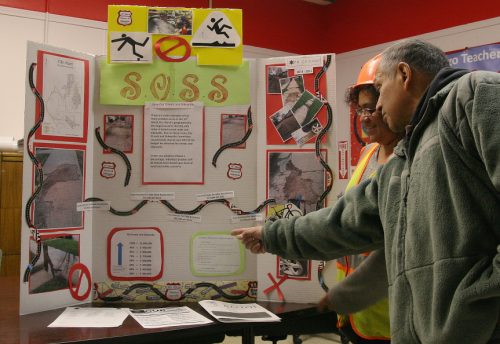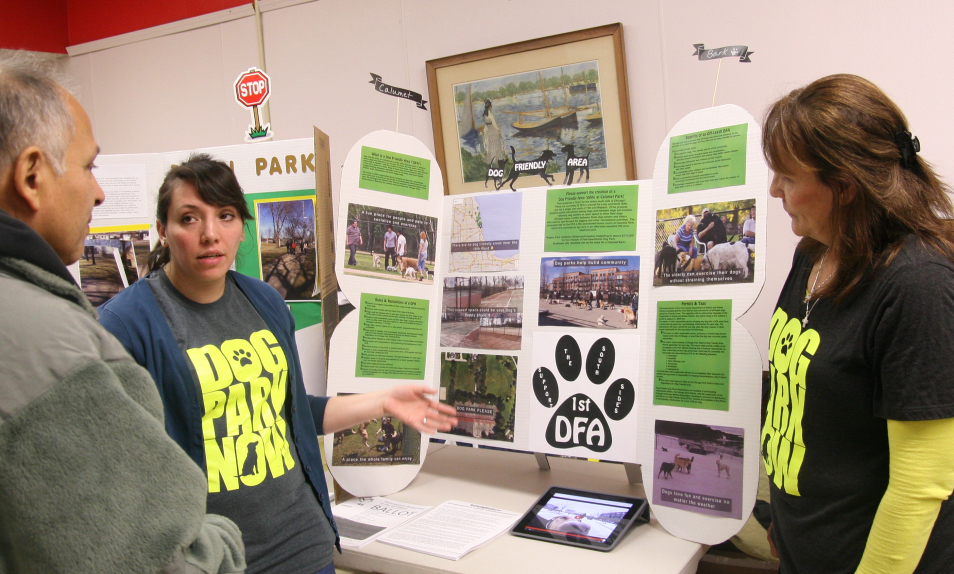The residents of the 10th Ward have been busy through the winter months, and they exhibited the fruits of their labor on Saturday, April 9, at the Participatory Budgeting Project Expo. Colorful posters and tri-folds lined the walls of the 10th Ward office, each depicting the benefits of a proposed community infrastructure project. A dog park proposal was decorated with intricate dog cutouts; the Streets and Sidewalks Committee connected sections of text with a winding road dotted with cracks; the Arts and Cultures poster showed vibrant pictures of murals and artwork.
These displays make up the project expo phase of Participatory Budgeting (PB), a process pioneered in 2010 by the 49th Ward, in which community members decide how to allocate some of the ward’s funds. In previous years, the alderman decided how to use the $1.3 million in “menu money” that each ward receives annually for discretionary infrastructure spending, such as road repairs and parks. This year, the 10th Ward is one of seven wards in Chicago to give residents the financial reins.
Toward the end of 2015, 10th Ward Alderwoman Susan Garza and her office held a series of meetings to spread the word about PB. This was followed by the idea-collection phase, which began in January. Residents could come to meetings to brainstorm potential uses for the money, as well as submit ideas online. By March, regular attendees of the PB meetings had been organized into committees focusing on areas such as streets and sidewalks, parks and recreation, and arts and culture. These committees took the lead on turning the ideas into full-fledged project proposals for residents to vote on from April 13 to April 21.

Committee heads were helped through this process by Garza’s office, with Chief of Staff Ismael Cuevas and staffer Nicole Garcia sorting through city databases to find relevant information. The staff also spent meetings explaining city ordinances and bureaucratic intricacies to the residents. As Cuevas told the Weekly, “Team collaborations have played a very important and critical role in the PB process. Bringing community members together from the largest ward in the city definitely posed various challenges.”
At a March 10 meeting, for example, Cuevas produced a map of the ward’s streets as marked by the Department of Transportation (DOT), as well as one by the Department of Water Management. Addressing the Streets and Sidewalks Committee, Cuevas noted, “If you look at this map, the majority of the ward is actually pretty decent, according to DOT standards. Now, there are streets that are damaged that aren’t marked on here. Do you notice how none of the streets that people suggested are in line with the DOT map?” The discrepancy, he explained, was due to overlaps with Water Management. Streets that have moratoriums on them have sewers that were done within the last twenty years and so cannot be repaved, “since they’re not going to tear up a street that was just fixed.” Additionally, some streets have one-hundred-year-old water mains underneath them. “That means Water Management will tear up the street, replace the water main, and do the repaving for free, not menu money. The only thing is that there are no dates. It depends on the budget, and it depends on the year. But they’re replacing them as a goal.”
Even with these limitations, though, there was plenty for the Streets and Sidewalks Committee to do. Cuevas told the committee, “If we were to add up all the streets, it’s easily a million dollars, especially because there are streets that we know are bad that people haven’t requested.” He recommended that the proposal be voted on as a percentage of the total menu money to be allocated to roadwork, and not by specific streets, so that the ward could easily pick and repave the worst streets.
Voting by percentage makes efficient allocation a bit easier, but it still leaves complications when it comes time for implementation. John Sandoval, a retired police officer and member of the Streets and Sidewalks Committee, explained one facet of erosion. “We have no curbs, so the streets get eroded, and it erodes toward the sidewalk and the grassy areas. But there are some areas that don’t want curbs, which we understand because it raises the value of their homes, and the taxes go up. So we’ll leave the curbs alone if the people there don’t want it.”
Kristal Stosich, a member of a separate organization called the Southeast Chicago Dog Park Committee, has been working in the Parks and Recreation Committee to secure menu money for a dog park. Her group has identified a set of unused tennis courts that can be converted and used to fill what she views as a community need. Emphasizing the project’s appeal with the dog-biscuit-shaped brownies she’d brought along, Stosich explained: “Adding a dog park would be so beneficial. We have support from our alderwoman, we have community support, we have a kind of a committee. The fact that it made the ballot got us so anxious and excited. It shows how much you want to see your project, and how hard you’re willing to work. We’re maybe a little sad if we’re not one of the winning projects. But it was a fun process, and there’s always next year.”
Everyone at the meeting seemed excited about PB in future years. Wynona Pyrtel and David Vance of the Arts and Culture Committee described the difficulties they’d had getting approval from building owners for murals, but expressed hope that seeing murals done from this year’s PB process might convince building owners in the future. Pyrtel said it’s a matter of “explaining to them that this isn’t graffiti, it’s professionally done by artists, and it wouldn’t take away from your building, it would enhance it.” Pyrtel added, “One area that kept coming up during the meetings was places for the children to play. So that’s another area that is going to be addressed, too. If not this year, then definitely the next year.”
There has been concern, however, about getting people to show up and vote. Attendance at the Project Expo was low, outside of the committee members who have been involved throughout the process. “It’s been slow, but we kind of figured it would be,” Stosich said. “And I’m Instagramming, and posting pictures on Facebook and whatnot. Those are getting some likes, so people are able to get an idea of what this expo is.” Cuevas explained that over the course of the process, “the 10th Ward office sent out weekly emails, featured an education piece in the 10th Ward newsletter that went out to 20,000 people, distributed flyers to local organizations and groups, and had PB meetings in all neighborhoods of the 10th Ward.” Plans have also been made to bring the posters to the voting sites in the coming weeks. Sandoval said he believes that the voting process will be a great success, though “we’ll have to see how many people come out and see these [posters], and vote. Even if we don’t have these displays at the voting locations, somebody will be there to explain it, and show them maybe on an iPad, or a mobile. Let the people decide, and let’s hope for the best.”
Early voting starts on April 13, but at the Expo, the excitement and dedication in the room were already palpable. “[Garza] has generated ten times more 10th Ward improvements than she could have done on her own,” Vance said. “By reaching out and building these committees she did ten times more than she could ever have done with her office staff. It’s an example of what other wards should try to do. If they don’t, they’re missing out.” As Sandoval sees it, “Voting is going to show us how much the community is actually going to impact this. So next year we can do it again, and it will be just the norm, for our neighborhood. And if we’re lucky, the whole city will do it this way. But then again, every community is different. I think the alderman works for the community, the community works for our alderman, and we work for our city.”

